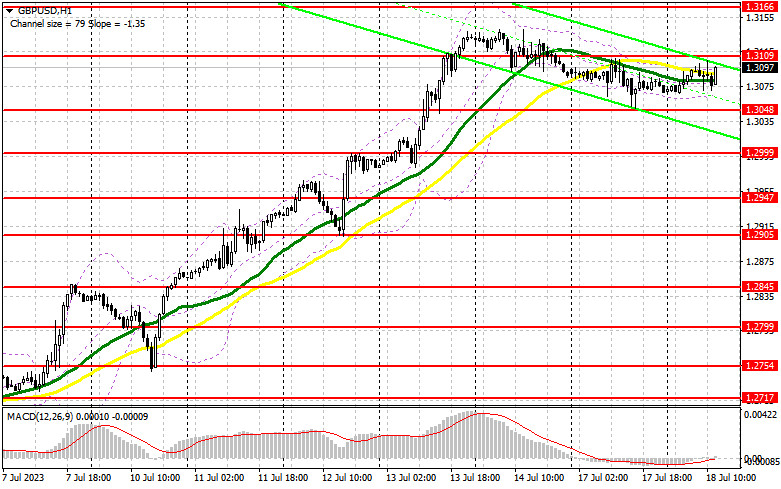
In my morning forecast, I emphasized the importance of the 1.3109 level and suggested making trading decisions based on it. Let's examine the 5-minute chart and analyze what occurred there. We were only a few pips away from testing this area, so we didn't receive a sell signal during the first half of the day. The technical outlook remains unchanged for the American session.

To initiate long positions on GBP/USD:
It is evident that buyers are determined to make another strong move towards 1.3109, and this time they might succeed. However, we have significant upcoming data on retail sales, industrial production, and a speech by FOMC member Michael S. Barr. Strong retail sales serve as direct evidence of sustained inflationary pressure, which may favor pound sellers and dollar buyers. In that case, I anticipate a buy signal only after a decline and the formation of a false breakout around the support level of 1.3048. The target will be the area around 1.3109, which we still need to reach today. A breakthrough and consolidation above this range will provide an additional buy signal, with a potential move toward 1.3166. The ultimate target will be the area around 1.3209, where I will take profits.
In the event of a decline in GBP/USD during the American session due to strong data and the absence of buyers at 1.3048, downward pressure on the pound will increase. In that scenario, a defense of the subsequent area at 1.3000 and a false breakout there will signal an opportunity to open long positions. I plan to buy GBP/USD only on a rebound from 1.2947, targeting a downward correction of 30-35 pips within the day.
To initiate short positions on GBP/USD:
Sellers are defending, but they are counting on strong US data in the second half of the day. Objectively, as long as trading remains below 1.3109, we can anticipate a further decline in the pair. In an upward trend, a false breakout at this level will serve as strong confirmation of the involvement of major market players. A sell signal from this level will result in a decline and a retest of the intermediate support at 1.3048, which was already tested during yesterday's trading. A breakthrough and subsequent reverse test of this range from bottom to top will deliver a more significant blow to buyer positions, pushing GBP/USD towards 1.3000. The ultimate target remains the minimum of 1.2947, where I will take profits.

If GBP/USD continues to rise during the second half of the day and there is no activity at 1.3109, the bullish market trend will persist. In such a case, I will postpone selling until the resistance level of 1.3166 is tested. A false breakout at that level will present an entry point for short positions. If there is no downward movement at that level, I will sell the pound immediately on a rebound from 1.3209, but only with the expectation of a downward correction of 30-35 pips within the day.
In the COT (Commitment of Traders) report for July 11, both long and short positions increased. However, buyers outnumbered sellers by a factor of two, confirming the bullish market trend we have observed throughout this month. Pound buyers have a definite opportunity to act more aggressively. On the one hand, the Federal Reserve, satisfied with the rapid decline in inflation, is reducing the likelihood of further interest rate hikes. On the other hand, despite the economic challenges, the Bank of England will continue to pursue a high-interest rate policy due to significant inflation issues affecting household living standards. The policy divergence will strengthen the pound and weaken the US dollar. Buying the pound on dips remains the optimal strategy. The latest COT report states that long non-commercial positions increased by 15,206 to 111,667, compared to 96,461, while short non-commercial positions only increased by 7,408 to 53,604, compared to 46,196. This resulted in another upward surge in the non-commercial net position to 58,063 from 50,265 a week earlier. The weekly closing price increased to 1.2932 from 1.2698.
Indicator Signals:
Moving Averages
Trading occurs around the 30-day and 50-day moving averages, creating certain difficulties for buyers.
Note: The author considers the period and prices of moving averages on the hourly chart (H1), which differs from the general definition of classic daily moving averages on the daily chart (D1).
Bollinger Bands
In the case of a decline, the lower boundary of the indicator, around 1.3050, will act as support.
Description of Indicators:
• Moving Average (determines the current trend by smoothing volatility and noise). Period 50. Marked in yellow on the chart.
• Moving Average (determines the current trend by smoothing volatility and noise). Period 30. Marked in green on the chart.
• MACD Indicator (Moving Average Convergence/Divergence) - Fast EMA period 12, Slow EMA period 26, SMA period 9.
• Bollinger Bands - Period 20.
• Non-commercial traders - speculators, such as individual traders, hedge funds, and large institutions, using the futures market for speculative purposes and meeting specific requirements.
• Long non-commercial positions represent the total long open positions of non-commercial traders.
• Short non-commercial positions represent the total short open positions of non-commercial traders.
• Net non-commercial position is the difference between short and long positions of non-commercial traders.